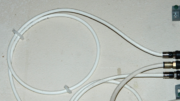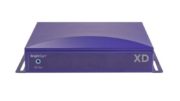Fiber optics are your friend if you have a very long cable run or if you need to fit into a very small space. If you’re working with a commercial DIRECTV system, you are running up to 7 pieces of coaxial cable with powered amplifiers about every 200 feet. This can be a big deal in older buildings that just don’t have the room for all that wire. In cases like that a fiber optic system is used. Up to 5 coaxial cables are converted into a single strand of fiber that’s about the thickness of your phone’s charger cable. Not only that, but the fiber line can be well over 1.5 miles long before you run into any problem whatsoever. Fiber is also used in installations where there is so much RF interference that even quad-shielded cables are unable to filter it out.
A fiber solution isn’t cheap, but it does work perfectly when you need it. For example a hotel could use a fiber solution when they want TV in the bar and the roof is 40 stories up.
There’s only one problem – you can’t use a SWM-enabled dish with a fiber solution. The way you do it is to use a legacy dish with 4 outputs and then on the other end of the fiber line, you use a SWM multiswitch. There are three reasons you can’t do this with a traditional fiber converter.
SWM needs two-way communication.
SWM is a two-way process. A request comes from the receiver, goes to the multiswitch (either the external one or the one built-in to the dish) and then the proper information is sent back. Today’s fiber solutions are strictly one-way, because two-way would be harder to engineer and you don’t need two-way in a “legacy” DIRECTV install.
SWM uses different frequencies.
In addition to the normal satellite frequencies of 950-2150 MHz, SWM uses a 2.3MHz control frequency for the signals back to the multiswitch. Again, this is something you would have to build into a fiber converter and it isn’t needed with the old-style systems.
Most important… they just don’t want you to.
That’s right, this mostly boils down to AT&T’s rules for commercial installations. If you’re installing in a commercial setting, you shouldn’t be using the SWM-enabled dish anyway, so using the fiber solutions that are out there should work for you.
In order for a system to be built that let a SWM signal travel over fiber, a company would have to determine that there is sufficient demand (there isn’t) and then they would have to convince the AT&T engineering staff that it’s worth their time to do it (it isn’t.) Then, AT&T would have to release its proprietary specs for SWM transmission, which most likely they wouldn’t (since other companies have asked and they haven’t.)
So you see it’s not really a technical limitation but like so many other things, it comes down to profits and to rules.





